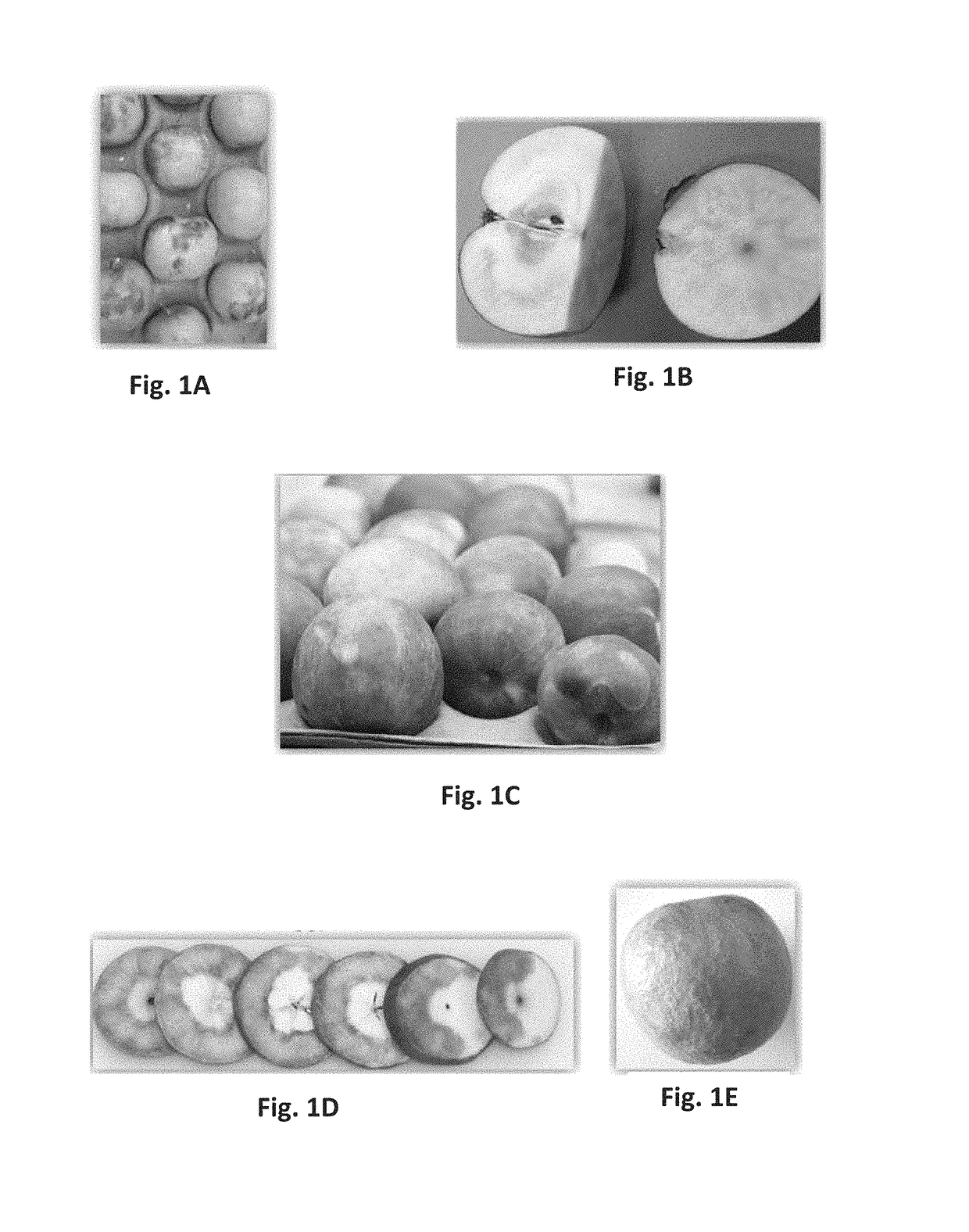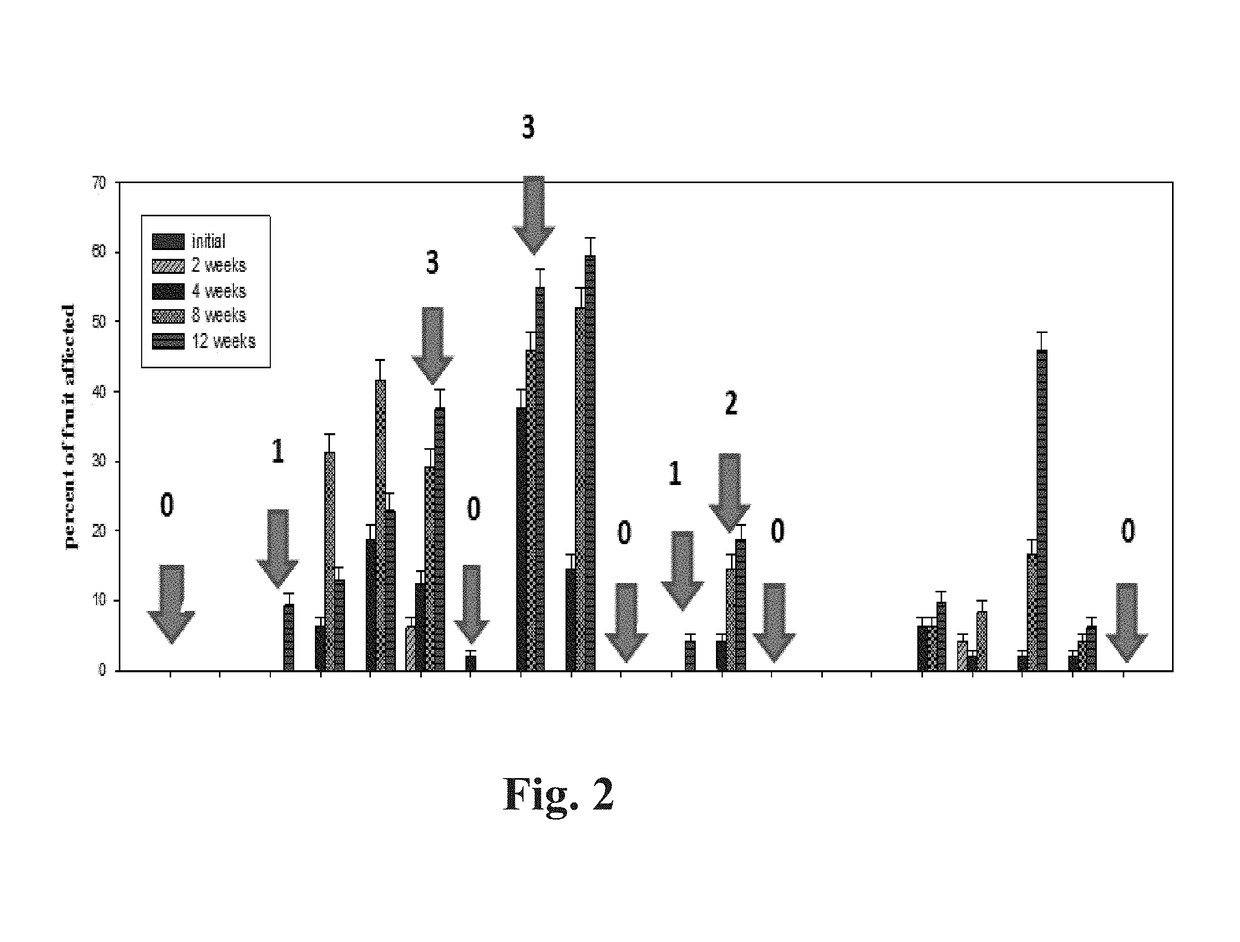Gene expression monitoring for risk assessment of apple and pear fruit storage stress and physiological disorders
a gene expression and risk assessment technology, applied in the field of biomarker-based risk assessment, can solve the problems of no biomarker identified, lack of methods for evaluating the risk of any of the multiple browning disorders materializing, and significant annual losses, and achieve the effect of reducing product loss
- Summary
- Abstract
- Description
- Claims
- Application Information
AI Technical Summary
Benefits of technology
Problems solved by technology
Method used
Image
Examples
example 1
Biomarker Discovery: Early Term Physiological Disorder Risk Assessment
[0060]For initial candidate selection, ‘Honeycrisp’ apples were obtained from 15 orchards distributed among the Lake Chelan / Brewster, Columbia Basin, and Yakima Valley growing regions in Washington State and the Hood River growing region of Oregon between Sep. 2 and Oct. 21, 2011. No pre-harvest treatments were applied, with the exception of Retain™, an ethylene biosynthesis inhibitor, (Valent BioScience Corporation, Libertyville, Ill., USA) to Orchard M. To determine the effects of harvest-timing on postharvest soft scald and soggy breakdown, fruit from one site was harvested at three different times, to represent an early, mid-, and late harvest (Orchard A). On the day of harvest, quality was assessed. Fruit were stored at 1° C. with no atmospheric modification and after 12 weeks, the final incidence of soft scald and soggy breakdown was assessed. For the selection process, the intent was to account for orchard ...
example 2
Biomarker Discovery: Late Term Physiological Disorder Risk Assessment
[0061]‘Granny Smith’ apples were harvested 140 days after full bloom (approximately 1 month prior to commercial harvest) at a research orchard near Orondo, Wash. After transport to the laboratory, analysis of fruit maturity and application of DPA and 1-MCP were performed. Apples were stored in air at 1° C. for up to 6 months. Six replications of 3 fruit per treatment were removed from storage at 1, 2, and 4 weeks and 2, 3, 4, and 6 months. Upon removal from storage, scald development was rated on a 0-4 scale and peel sampled and stored from each treatment for subsequent analysis. In a parallel experiment, additional apples were treated with 2000 mg L−1 DPA after 1-4 weeks, and 2 months after storage inception to determine the length of the transitional period during which scald can be suppressed. Scald development on these fruit was evaluated after 2, 3, 4, and 6 months storage.
example 3
Gene Expression Evaluation: RNA Extraction and RNAseq Profiling
[0062]Harvested apple tissue was immediately snap frozen in liquid nitrogen and stored at −80° C. until required. Tissue was ground into a fine powder in liquid N2 and total RNA was extracted from 500 mg of tissue in 0.8 mL of extraction buffer (4M guanidine isothiocyanate, 25 mM EDTA, 2.5% polyvinylpyrollidone (MW 40,000), 2% sarkosyl, 1% β-mercaptoethanol, 0.2M sodium acetate, pH 5.0) at 70° C. for 10 min. Following incubation, chloroform (0.8 mL) was added, tubes vortexed and then spun in a benchtop centrifuge at top speed for 15 minutes. The resulting upper aqueous phase was collected, and a half volume of ethanol added and mixed by inversion. Total RNA was then purified through columns as per the manufacturer's instructions (Qiagen, RNAeasy), and eluted in nuclease free water. The resulting total RNA was checked for integrity via gel electrophoresis then quantified and diluted appropriately.
[0063]Libraries for RNAse...
PUM
| Property | Measurement | Unit |
|---|---|---|
| storage temperatures | aaaaa | aaaaa |
| storage temperatures | aaaaa | aaaaa |
| storage temperature | aaaaa | aaaaa |
Abstract
Description
Claims
Application Information
 Login to View More
Login to View More - R&D
- Intellectual Property
- Life Sciences
- Materials
- Tech Scout
- Unparalleled Data Quality
- Higher Quality Content
- 60% Fewer Hallucinations
Browse by: Latest US Patents, China's latest patents, Technical Efficacy Thesaurus, Application Domain, Technology Topic, Popular Technical Reports.
© 2025 PatSnap. All rights reserved.Legal|Privacy policy|Modern Slavery Act Transparency Statement|Sitemap|About US| Contact US: help@patsnap.com



